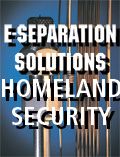Homeland Security
Participants in this Technology Forum are Richard Jack of Dionex, Jack Cochran of Restek, and Lucas Smith of LECO.

Homeland security applications present chemists with a number of challenging analytes, ranging from biological and chemical warfare agents to water adulterants and toxic industrial compounds. Participants in this Technology Forum are Richard Jack of Dionex, Jack Cochran of Restek, and Lucas Smith of LECO.
What is the current state-of-the-art in separations-related instrumentation and methodology for homeland security applications?
Jack: Most separations equipment is adequate for determining the initial components for homeland security, or disruption of drinking water supplies. Methods are currently being validated by the US EPA for such purposes.
Cochran:The state-of-the-art for homeland security sample analysis is gas chromatography (GC) with mass spectrometry (MS), either in the field or the lab. But there’s quite a bit of diversity in the platforms, from small, portable ion-trap MS systems (one with a short-column, fast-heating, low thermal-mass GC front end), to laboratory GC–tandem mass spectrometers for targeted analytes, to GC–time-of-flight (TOF) MS systems that are better for comprehensive screening.
Actually though, the mass spectrometers that interest me most for homeland security applications are those that don’t even have chromatographic separation means, the ones with ambient or desorption ionization sources that can directly (and rapidly) analyze samples without preparation. There’s some interesting stuff coming out of the labs of Graham Cooks and Gary Hieftje, for example. Connect one of those sources to an accurate mass TOF-MS system and you have a really powerful unknown compound identification tool. I’ll stay away from the trite Tricorder reference; oops, I guess it’s too late.
Smith:TOF-MS represents the “state of the art” in homeland security applications. This is due to the nature of the instrumentation as these mass spectrometers are robust, capable of incredible throughput, possess a wide dynamic range, and offer near SIM mode sensitivity across a full mass range. This high sensitivity across a full mass range makes TOF-MS systems ideal for the analysis of both known and unknown compounds, which can be vital to homeland security applications.
What are the greatest challenges in analyzing the compounds currently encountered in homeland security applications?
Jack:Most challenges will deal with online monitoring to detect early warning of contamination. Right now there is no mandate for drinking water utilities to have such systems in place.
Cochran:Probably finding compounds in matrix background, especially if they aren’t already known or targeted. That is where sensitive, full mass-range MS systems shine, especially higher resolving power, accurate mass instruments. Sample preparation may be minimal for speed, so sample background can be quite complex. And there are nominal mass GC–TOF-MS units out there with powerful peak finding and spectral deconvolution algorithms that are very helpful in ferreting out possible chemical warfare compounds, toxic industrial chemicals, food or water adulterants, and so forth.
Given the speed of some of the GC–MS systems on the market today, which is beneficial for homeland security applications, another challenge is getting samples prepped quickly enough to feed the instruments. Fast batch approaches like QuEChERS (quick, easy, cheap, effective, safe) can do it, and headspace sampling systems like solid-phase microextraction (SPME) are appropriate in some cases.
Smith:The greatest challenge currently faced in homeland security applications is the need to offer quick response to, potentially, any site in the country while being prepared to analyze for a huge list of potential threats. Of near equal importance is the need for throughput on-site.
Which separations techniques are the most widely used in homeland security applications?
Jack:Most involve reversed-phase separations with MS detection.
Cochran:If you consider the chemical compounds of homeland security concern, many, maybe even most (for example, organophosphorus nerve agents, the blister compounds like mustards, hydrogen cyanide and cyanogen chloride, toxic industrial chemicals, many pesticides) can be gas chromatographed, albeit not without problems or derivatization sometimes. Other compounds, like ricin, require liquid separations.
What new challenges are on the horizon for homeland security analysts?
Jack:The biggest challenges are the development of validated methods for the vast array of chemicals, such as pesticides, rodenticides, herbicides, and so forth, that can damage or disrupt drinking water supplies. There are probably thousands of such compounds.
Cochran:Quickly analyzing for lower-level, unknown toxic compounds in complex samples is the new challenge, in my opinion. Target analysis is relatively straightforward and there are good, robust methods in place for many of the compounds of concern. But if the bad guys know what we’re looking for, they’re probably going to try something else, and we need to be ready with broad-based screening approaches like LC–TOF-MS and GC–TOF-MS.
An example of the necessity for sensitive, full-mass-range MS systems, although not specifically a homeland security case, is the unintentional poisoning of an infant in 2002 in New York by an illegally imported Chinese rodenticide, tetramethylenedisulfotetramine (TETS). Targeted analysis screens for rodenticides and insecticides failed to detect TETS in the infant poisoning. Apparently 7–10 mg of TETS is lethal in humans. TETS is reportedly 100 times more toxic than potassium cyanide and a more powerful human convulsant than strychnine. In that same year, a snack shop owner in China adulterated a competitor’s food with TETS, which resulted in over 30 deaths.
I think the cases above illustrate we have to expect the unexpected, and hopefully we’ll have the tools and skills to rapidly analyze for nontarget compounds at low levels in our air, our food, and our water for homeland security.
Smith:One of the challenges that we will face in the future will be an ever-increasing list of compounds of concern. As those who threaten our country are constantly seeking new ways to do so and to accomplish the feat without detection, Homeland Security must also stay vigilant and ensure that they continue to evolve to the threat. Instrumentation must therefore be capable of identifying not only known compounds but also those unknown agents that could pose a significant risk.
If you are interested in participating in any upcoming Technology Forums please contact Group Technical Editor Steve Brown or Associate Editor Meg Evans for more information. Next month’s forums will focus on the GC–MS and Petro/Biofuel markets.
Best of the Week: Food Analysis, Chemical Migration in Plastic Bottles, STEM Researcher of the Year
December 20th 2024Top articles published this week include the launch of our “From Lab to Table” content series, a Q&A interview about using liquid chromatography–high-resolution mass spectrometry (LC–HRMS) to assess chemical hazards in plastic bottles, and a piece recognizing Brett Paull for being named Tasmanian STEM Researcher of the Year.
Using LC-MS/MS to Measure Testosterone in Dried Blood Spots
December 19th 2024Testosterone measurements are typically performed using serum or plasma, but this presents several logistical challenges, especially for sample collection, storage, and transport. In a recently published article, Yehudah Gruenstein of the University of Miami explored key insights gained from dried blood spot assay validation for testosterone measurement.
Determination of Pharmaceuticals by Capillary HPLC-MS/MS (Dec 2024)
December 19th 2024This application note demonstrates the use of a compact portable capillary liquid chromatograph, the Axcend Focus LC, coupled to an Agilent Ultivo triple quadrupole mass spectrometer for quantitative analysis of pharmaceutical drugs in model aqueous samples.
